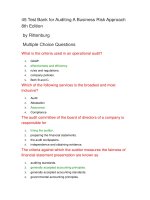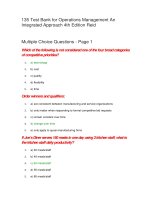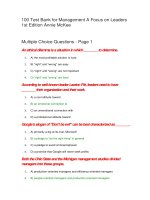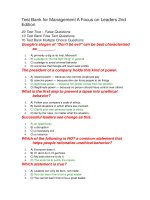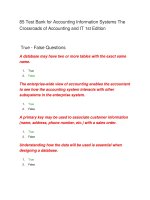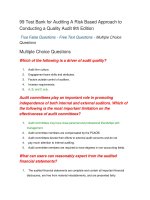Test bank for nursing a concept based approach to learning volume 1 1st edition by NCCLEB
Bạn đang xem bản rút gọn của tài liệu. Xem và tải ngay bản đầy đủ của tài liệu tại đây (110.16 KB, 33 trang )
Full file at />
CONCEPT 1: Acid-Base Balance
About
1. A client is brought to the emergency department after passing out in a local department
store. The client reports having dieted by fasting for the last 5 days. Which acid–base
imbalance would the nurse expect to assess in this client?
1. Respiratory acidosis
2. Respiratory alkalosis
3. Metabolic acidosis
4. Metabolic alkalosis
Answer:
3. Metabolic acidosis
Rationale:
A client who is fasting is at risk for development of metabolic acidosis. The body
recognizes fasting as starvation and begins to metabolize its own proteins into ketones,
which are metabolic acids. Starvation would not result in respiratory acidosis or alkalosis
or in metabolic alkalosis.
Nursing Process: Assessment
Client Need: Physiological integrity
Cognitive Level: Analyzing
Learning Outcome: 1. Summarize the structure and physiological processes of the acid–
base regulatory systems related to acid–base balance.
2. Which of the following risk factors would be of concern to the nurse who is planning
care for a group of clients with metabolic acidosis? (Select all that apply.)
buy this full document at
Full file at />
1. Chronic obstructive pulmonary disease
2. Hypovolemic shock
3. Pneumonia
4. Abdominal fistulas
5. Acute renal failure
Answer:
2. Hypovolemic shock
4. Abdominal fistulas
5. Acute renal failure
Rationale:
Metabolic acidosis is rarely a primary disorder. It usually develops during the course of
another disease such as shock, presence of abdominal fistulas, which can cause excess
bicarbonate loss, and acute renal failure. Chronic obstructive pulmonary disease and
pneumonia places the client at risk for respiratory acidosis with the increased retention of
carbon dioxide in the blood.
Nursing Process: Assessment
Client Need: Physiological Integrity
Cognitive Level: Applying
Learning Outcome: 2. List factors affecting acid–base balance.
3. A child with croup has an increased PaCO2, a decreased pH, and a normal H2CO3
blood-gas value. The nurse interprets this as uncompensated:
1. Respiratory acidosis.
2. Respiratory alkalosis.
3. Metabolic acidosis.
4. Metabolic alkalosis.
buy this full document at
Full file at />
Answer: 1. Respiratory acidosis.
Rationale:
If the pH is decreased and the PaCO2 is increased with a normal H2CO3, it is
uncompensated respiratory acidosis. In addition, croup can be a disease process that
causes respiratory acidosis. Uncompensated respiratory alkalosis has an increased pH,
decreased PaCO2, and normal H2CO3. Uncompensated metabolic acidosis has a decreased
pH, normal PaCO2, and normal H2CO3. Uncompensated metabolic alkalosis has an
increased pH, normal PaCO2, and increased H2CO3.
Nursing Process: Planning
Client Need: Physiological Integrity
Cognitive Level: Analyzing
Learning Outcome: 3 Identify commonly occurring alterations in acid–base balance and
their related treatments.
4. The client has a medical condition that often results in the development of metabolic
acidosis. The nurse should observe this client for the development of which breathing
pattern as a result of this condition?
1. Cheyne-Stokes
2. Biot’s
3. Cluster
4. Kussmaul’s
Answer:
4. Kussmaul’s
Rationale:
Kussmaul’s respirations are a type of hyperventilation that accompanies metabolic
acidosis. They represent the body’s attempt to compensate for the acidosis by “blowing
off” carbon dioxide. Cheyne-Stokes respirations are commonly a result of congestive
buy this full document at
Full file at />
heart failure, increased intracranial pressure, or drug overdose. Cluster and Biot’s
respirations are the same and are often the result of central nervous system disorders.
Nursing Process: Assessment
Client Need: Physiological integrity
Cognitive Level: Applying
Learning Outcome: 4. Explain common physical assessment procedures used to
examine acid–base health of clients across the life span.
5. A client has been admitted with probable emphysema. Diagnostic tests have been
ordered. Which of the tests will provide the most accurate indicator of the client’s acid–
base balance?
1. Bronchoscopy
2. Sputum studies
3. Pulse oximetry
4. Arterial blood gases (ABGs)
Answer:
4. Arterial blood gases (ABGs)
Rationale:
ABGs are done to assess alterations in acid–base balance caused by respiratory disorders,
metabolic disorders, or both. A bronchoscopy provides visualization of internal
respiratory structures. Sputum studies can provide specific information about bacterial
organisms. Pulse oximetry is a noninvasive test that evaluates the oxygen saturation level
of blood.
Nursing Process: Evaluation
Client Need: Physiological Need
Cognitive Level: Applying
buy this full document at
Full file at />
Learning Outcome: 5. Outline diagnostic and laboratory tests to determine the
indicidual’s acid–base status.
6. The nurse is monitoring the urine specific gravity and pH on a child receiving
chemotherapy. The nurse will try to maintain the urine values at:
1. Spec gravity 1.030; pH 6.
2. Spec gravity 1.030; pH 7.5.
3. Spec gravity 1.005; pH 6.
4. Spec gravity 1.005; pH 7.5.
Answer:
4. Spec gravity 1.005; pH 7.5.
Rationale:
Because the breakdown of malignant cells releases intracellular components into the
blood and electrolyte imbalance causes metabolic acidosis, the urine specific gravity
should remain at less than 1.010 and the pH at 7 to 7.5. A specific gravity higher than
1.010 can mean fluid intake is not high enough, and a pH of less than 7 means acidosis.
Nursing Process: Assessment
Client Need: Physiological Integrity
Cognitive Level: Analyzing
Learning Outcome: 6. Explain management of acid–base balance and prevention of
imbalances.
Source: Unknown
7. The client who was diagnosed with diabetes mellitus 1 year ago is hospitalized in
diabetic ketoacidosis after a religious fast. The client tells the nurse, “I have fasted during
this season every year since I became an adult. I am not going to stop now.” The nurse is
not knowledgeable about this particular religion. What is the best action for this nurse?
buy this full document at
Full file at />
1. Tell the client that it is different now because of the diabetes.
2. Do some research into the meaning of fasting in this religion.
3. Ask family members of the same religion to discuss fasting with the client.
4. Request a consult from a diabetes educator.
Answer:
4. Request a consult from a diabetes educator.
Rationale:
The diabetes educator should be contacted to work with the client on strategies that might
allow the fasting to occur in a safe manner. Telling the client that life is different now
does not support religious beliefs. Research into the meaning of fasting in this religion
would be educative for the nurse, but the client requires more immediate intervention.
Asking the family to talk to the client might help, but the diabetes educator would be able
to provide more direct and helpful information for the client.
Nursing Process: Planning
Client Need: Psychosocial integrity
Cognitive Level: Analyzing
Learning Outcome: 7. Demonstrate the nursing process in providing culturally
competent and caring interventions across the life span for individuals with common
alterations in acid–base balance.
8. The client is receiving sodium bicarbonate intravenously (IV) for correction of acidosis
secondary to diabetic coma. The nurse assesses cyanosis, slow respirations, and irregular
pulse. What is the nurse’s priority action?
1. Continue the infusion; the client is still in acidosis.
2. Increase the rate of the infusion and continue to assess the client for symptoms of
acidosis.
3. Stop the infusion and notify the physician; the client is in alkalosis.
buy this full document at
Full file at />
4. Decrease the rate of the infusion and continue to assess the client for symptoms of
alkalosis.
Answer:
3. Stop the infusion and notify the physician; the client is in alkalosis.
Rationale:
The client receiving sodium bicarbonate is prone to alkalosis; monitor for cyanosis, slow
respirations, and irregular pulse. The client’s symptoms indicate alkalosis so infusion
must be stopped and the physician notified. The client is not in acidosis; symptoms of
acidosis include lethargy, confusion, CNS depression leading to coma, and a deep, rapid
respiration rate that indicates an attempt by the lungs to rid the body of excess acid. The
client is not in acidosis, so the infusion must be stopped, not increased or decreased.
Nursing Process: Implementation
Client Need: Physiological Integrity
Cognitive Level: Analyzing
Learning Outcome: 8. Identify pharmacological interventions in caring for the
individual with alterations in acid–base balance.
Exemplar 1.1: Metabolic Acidosis
1. The client’s arterial blood gas report reveals a pH of 6.58. How does the nurse
evaluate this value?
1. There is a slight elevation.
2. This value is incompatible with life.
3. This is a low normal value.
4. This value is extremely elevated.
buy this full document at
Full file at />
Answer:
2. This value is incompatible with life.
Rationale:
The body’s pH range is normally 7.35 to 7.45. Values lower than 6.8 or higher than 7.8
are generally considered incompatible with life. If the nurse assesses that this client is
physiologically more stable than would be expected with this pH, the possibility of a lab
error should be considered. An elevated pH would be greater than 7.45, and an extremely
elevated pH would be much greater than 7/45. A low normal value would be closer to
7.35.
Nursing Process: Evaluation
Client Need: Physiological Integrity
Cognitive Level: Analyzing
Learning Outcome: 1. Describe the pathophysiology, etiology, clinical manifestations,
and direct and indirect causes of metabolic acidosis.
2. The mother of a 1-month-old infant calls the nurse who works in the health clinic. The
mother is concerned because the infant has had vomiting and diarrhea for 2 days. What
instruction should the nurse give this infant’s mother?
1. Bring the infant to the clinic for evaluation.
2. Give the infant at least 2 ounces of juice every 2 hours.
3. Measure the infant’s urine output for 24 hours.
4. Provide the infant with 50 mL of glucose water.
Answer:
1. Bring the infant to the clinic for evaluation.
Rationale:
buy this full document at
Full file at />
Parents and caregivers need to be taught the seriousness of vomiting or diarrhea in infants
due to rapid fluid loss that can occur in this age group. They should also be taught the
importance of bringing an infant in this situation to health care providers for evaluation.
Encouraging fluids for an infant who is actively vomiting will not improve fluid balance
status, nor is juice or glucose water the best choice of fluid. Simply monitoring the loss
over the next 24 hours would increase the potential for the infant to become dehydrated.
Nursing Process: Planning
Client Need: Physiological integrity
Cognitive Level: Applying
Learning Outcome: 2. Identify risk factors associated with metabolic acidosis.
3. The nurse is assessing an African American client whose cultural background is
different from the cultural background of the nurse. The client has symptoms of
metabolic acidosis. Which of the following situations would illustrate prejudice on the
nurse’s part?
1. Making an assumption that all members of each culture are alike
2. Understanding that all culture members will have the same beliefs
3. Bringing previous negative information and experiences into this situation
4. Taking general knowledge from literature and applying it to the situation
Answer:
3. Bringing previous negative information and experiences into this situation
Rationale:
Prejudice is a negative belief or preference that is generalized about a group, which leads
to “prejudgment.” Prejudice occurs when the person making the judgment generalizes an
experience of one individual from a culture to all members of that group. The other
options describe stereotypical behavior, which is assuming that all members of a culture
or ethnic group are alike.
buy this full document at
Full file at />
Nursing Process: Evaluation
Client Need: Psychosocial integrity
Cognitive Level: Analyzing
Learning Outcome: 3. Illustrate the nursing process in providing culturally competent
care across lifespan for individuals with metabolic acidosis.
4. The nurse is caring for a client who has been admitted with persistent diarrhea lasting 3
days. Which of the following is a priority nursing diagnosis for this client?
1. Risk for Infection
2. Decreased Cardiac Output
3. Knowledge Deficit
4. Pain
Answer:
2. Decreased Cardiac Output
Rationale:
Metabolic acidosis affects cardiac output by decreasing contractility, slowing the heart
rate, and increasing the risk for dysrhythmias. While the client may be at risk for
infection, a knowledge deficit, and pain, the potential for decreased cardiac output would
be the priority nursing diagnosis in the acute phase.
Nursing Process: Diagnosis
Client Need: Physiological Integrity
Cognitive Level: Analyzing
Learning Outcome: 4. Formulate priority nursing diagnoses appropriate for an
individual with metabolic acidosis.
buy this full document at
Full file at />
5. The client who has been diagnosed with diabetes mellitus type 1 asks the nurse what
this means. What is the best response by the nurse? (Select all that apply.)
1. “The exocrine function of your pancreas is to secrete insulin.”
2. “It means your pancreas cannot secrete insulin.”
3. “The endocrine function of your pancreas is to secrete insulin.”
4. “Your alpha cells should be able to secrete insulin, but cannot.”
5. “Without insulin you will develop ketoacidosis.”
Answers:
2. “It means your pancreas cannot secrete insulin.”
3. “The endocrine function of your pancreas is to secrete insulin.”
5. “Without insulin you will develop ketoacidosis.”
Rationale:
One function of the pancreas is to secrete insulin. The endocrine function of the pancreas
is to secrete insulin. A consequence of diabetes mellitus type 1 is that without insulin,
severe metabolic disturbances, such as diabetic ketoacidosis (DKA) will result. The
endocrine, not the exocrine, function of the pancreas is to secrete insulin.Insulin is
secreted by the beta, not the alpha, cells of the pancreas.
Nursing Process: Implementation
Client Need: Physiological Integrity
Cognitive Level: Applying
Learning Outcome: 5. Create a plan of care for individuals with metabolic acidosis and
their family members.
6. The nurse is caring for a client admitted with renal failure and metabolic acidosis.
Which of the following signs would indicate to the nurse that planned interventions have
been effective?
buy this full document at
Full file at />
1. Increased deep tendon reflexes
2. Weight gain
3. Decreased respiratory rate
4. Palpitations
Answer:
3. Decreased respiratory rate
Rationale:
The client with metabolic acidosis will have an increased respiratory rate and depth. A
sign that care has been effective would include a decrease in the rate and depth of
respirations. Increased deep tendon reflexes, weight gain, and palpitations are not
associated with metabolic acidosis.
Nursing Process: Evaluation
Client Need: Physiological Integrity
Cognitive Level: Applying
Learning Outcome: 6. Assess expected outcomes for an individual with metabolic
acidosis.
7. The nurse is caring for the client experiencing hypovolemic shock and metabolic
acidosis. Which of the following therapies would the nurse question if planned for this
client?
1. Administration of sodium bicarbonate
2. Monitor ECG for conduction problems
3. Monitor daily weights
4. Limit the intake of fluids
Answer:
4. Limit the intake of fluids
buy this full document at
Full file at />
Rationale:
The treatment for hypovolemic shock would include the administration of fluids, not
limiting fluids. Administering sodium bicarbonate and monitoring daily weights and
ECGs are all appropriate for the client with shock.
Nursing Process: Intervention
Client Need: Physiological Integrity
Cognitive Level: Applying
Learning Outcome: 7. Discuss therapies used in the collaborative care of an individual
with metabolic acidosis.
8. A client with metabolic acidosis has been admitted to the unit from the emergency
room. Which of the following does the nurse implement as a priority of care for this
client?
1. Administration of sodium bicarbonate.
2. Protect the client from injury.
3. Give the client skin care.
4. Place the client in a high-Fowler’s position
Answer:
2. Protect the client from injury
Rationale:
The client with metabolic acidosis may have symptoms of drowsiness, lethargy,
confusion, and weakness. A priority of care would be preventing injury to the client.
Medication administration is a physician order. Skin care would not be a priority on
admission. The high-Fowler’s position would not be the safest position for the confused
client.
Nursing Process: Implementation
buy this full document at
Full file at />
Client Need: Physiological Integrity
Cognitive Level: Analyzing
Learning Outcome: 8. Employ evidence-based caring interventions for an individual
with metabolic acidosis
Exemplar 1.2: Metabolic Alkalosis
1. The client has been vomiting for several days. What will the best assessment of the
nurse include?
1. Respiratory acidosis
2. Respiratory alkalosis
3. Metabolic alkalosis
4. Metabolic acidosis
Answer:
3. Metabolic alkalosis
Rationale:
Metabolic alkalosis will result from excessive loss of hydrochloric acid from the stomach
brought on by prolonged vomiting. Respiratory acidosis will not occur as a result of
vomiting. Respiratory alkalosis will not occur as a result of vomiting. Metabolic acidosis
will not occur as a result of vomiting.
Nursing Process: Assessment
Client Need: Physiological Integrity
Cognitive Level: Analyzing
Learning Outcome: 1. Describe the pathophysiology, etiology, clinical manifestations,
and direct and indirect causes of metabolic alkalosis.
buy this full document at
Full file at />
2. The nurse is caring for a client who has been admitted with metabolic alkalosis. Which
of the following data collected during the nursing assessment leads the nurse to conclude
that the patient is at risk for this diagnosis?
1. The client takes ibuprophen for pain once a week.
2. The client takes a baby aspirin once daily.
3. The client frequently uses calcium carbonate (Tums®) for acid indigestion.
4. The client takes metformin daily.
Answer:
3. The client frequently uses calcium carbonate (Tums®) for acid indigestion.
Rationale:
Excessive use of calcium carbonate can cause metabolic alkalosis. Use of ibuprophen and
metformin is not associated with alkalosis. Overuse of aspirin can be associated with
metabolic acidosis.
Nursing Process: Assessment
Client Need: Physiological Integrity
Cognitive Level: Applying
Learning Outcome: 2. Identify the risk factors associated with metabolic alkalosis.
3. An Asian-American adolescent is hospitalized following several days of vomiting
following food poisoning. The nurse is planning to include which of the following points
when teaching the client’s family? (Select all that apply.)
1. Signs and symptoms of metabolic alkalosis
2. Nutritional patterns of the adolescent
3. Proper food handling techniques
4. Immunizations for the adolescent
5. Normal laboratory values of the client
buy this full document at
Full file at />
Answers:
1. Signs and symptoms of metabolic alkalosis
3. Proper food handling techniques
Rationale:
The family of anyone experiencing prolonged vomiting should be taught the signs and
symptoms of metabolic alkalosis. In this case, the nurse would include teaching about
proper methods of food handling to prevent further episodes of food poisoning. Food
patterns of the adolescent are not the precipitating factor of the food poisoning, nor would
immunizations prevent this disease. Unless the family asks, it is not necessary to teach
normal laboratory findings.
Nursing Process: Implementation
Client Need: Health Promotion and Maintenance
Cognitive Level: Applying
Learning Objective: 3. Illustrate the nursing process in providing culturally competent
care across the lifespan for individuals with metabolic alkalosis.
4. The nurse is planning care for the client who has been admitted with metabolic
alkalosis. Which of the following is a priority nursing diagnosis for this client?
1. Fluid Volume Excess
2. Risk for Impaired Gas Exchange
3. Risk for Hypothermia
4. Ineffective Health Maintenance
Answer:
2. Risk for Impaired Gas Exchange
Rationale:
buy this full document at
Full file at />
Respiratory compensation for metabolic alkalosis includes depression of the respiratory
rate and reduction of the depth of respirations leading to the retention of carbon dioxide.
Clients with metabolic alkalosis often have an accompanying fluid volume deficit. With
the fluid volume deficit, the client would experience hyperthermia. Ineffective health
maintenance would not be a priority during the acute phase of the disease but, rather, a
teaching opportunity before discharge depending on the cause of the metabolic alkalosis.
Nursing Process: Planning
Client Need: Physiological Integrity
Cognitive Level: Applying
Learning Outcome: 4. Formulate priority nursing diagnoses appropriate for an
individual with metabolic alkalosis.
5. The nurse is planning care for the client who has been admitted with severe metabolic
alkalosis. Which of the following interventions does the nurse plan for this client?
1. Walking outside on the hospital grounds twice each day
2. Bath, linen change, physical therapy, and ambulation each morning
3. Waiting for late afternoon to complete all nursing activities
4. Scheduling nursing activities to allow for periods of rest
Answer:
4. Scheduling nursing activities to allow for periods of rest
Rationale: The client with severe metabolic alkalosis is hypoxemic and has limited
energy reserves. Spacing nursing activities throughout the day allows the client ample
rest time. Scheduling activities all at the same time or that are too strenuous, such as
walking outside, are not reasonable goals for the client in oxygen debt.
Nursing Process: Planning
Client Need: Physiological Integrity
Cognitive Level: Analyzing
buy this full document at
Full file at />
Learning Outcome: 5. Create a plan of care for individuals with metabolic alkalosis and
their family members.
6. The nurse determines that teaching has been effective for the client with metabolic
alkalosis if the client states which of the following?
1. “I will use only sodium bicarbonate as my antacid.”
2. “I will take antacids only for my gastric discomforts.”
3. “I will eat foods high in potassium while I am taking Lasix.”
4. “I will restrict my intake of fluids.”
Answer:
3. “I will eat foods high in potassium while I am taking Lasix.”
Rationale:
The client on Lasix (furosemide) may lose excess potassium and dispose the client
toward metabolic alkalosis. The client is taught to refrain from the use of sodium antacids
when prone to metabolic alkalosis. The client should consult with the primary care
provider for gastric distress rather than self medication. The client who is prone to
metabolic alkalosis is likely to have fluid deficits and would not be instructed to restrict
fluids.
Nursing Process: Evaluation
Client Need: Physiological Integrity
Cognitive Level: Analyzing
Learning Outcome: 6. Assess expected outcomes for an individual with metabolic
alkalosis.
buy this full document at
Full file at />
7. A client with severe metabolic alkalosis has been admitted to the unit and is being
cared for by a nursing student along with the nurse. Which of the following does the
nurse tell the student is a priority treatment for this client?
1. Determining the underlying cause of the metabolic alkalosis
2. Administering medication for metabolic alkalosis
3. Teaching the client the risk factors for metabolic alkalosis
4. Setting goals for the client with metabolic alkalosis
Answer:
1. Determining the underlying cause of the metabolic alkalosis
Rationale:
Metabolic alkalosis rarely occurs as a primary disorder and the priority would be to
determine the underlying cause of the problem. Administering medications will be
needed as a treatment, but the priority is to discover the cause. Teaching the client and
setting goals are important aspects of nursing care but are not the priority.
Nursing Process: Assessment
Client Need: Physiological Integrity
Cognitive Level: Applying
Learning Outcome: 7. Discuss therapies used in the collaborative care of an individual
with metabolic alkalosis.
8. A client who has had persistent vomiting for four days has been admitted to the unit.
The nurse determines that the best position for this client is which of the following?
1. Right Sims position
2. Left side lying position
3. Semi-Fowler’s position
4. Prone position
buy this full document at
Full file at />
Answer:
3. Semi-Fowler’s position
Rationale:
The client with prolonged vomiting will likely have severe metabolic alkalosis with
reduced oxygenation. The semi-Fowler’s position will facilitate alveolar ventilation with
improved oxygenation. Side-lying and prone positions do not facilitate needed lung
expansion.
Nursing Process: Implementation
Client Need: Physiological Integrity
Cognitive Level: Analyzing
Learning Outcome: 8. Employ evidence-based caring interventions for an individual
with metabolic alkalosis.
Exemplar 1.3: Respiratory Acidosis
1. The nurse has admitted a client who was brought to the hospital after a narcotic
overdose. What acid–base imbalance does the nurse expect to observe in this client?
1. Respiratory acidosis
2. Respiratory alkalosis
3. Metabolic acidosis
4. Metabolic alkalosis
Answer:
1. Respiratory acidosis
Rationale:
buy this full document at
Full file at />
Since narcotics generally act to decrease or suppress respirations, this client is probably
hyperventilating. The expected acid–base imbalance would be respiratory acidosis.
Respiratory alkalosis, metabolic acidosis, and metabolic alkalosis are caused by many
conditions, none of which are related to this client’s narcotic overdose.
Nursing Process: Planning
Client Need: Physiological Integrity
Cognitive Level: Analyzing
Learning Outcome: 1. Describe the pathophysiology, etiology, clinical manifestations,
and direct and indirect causes of respiratory acidosis.
2. The nurse is caring for a client who has been admitted to the unit with respiratory
failure and respiratory acidosis. Which data from the nursing history would the nurse
suspect contributed to the client’s current state of health?
1. Thoracic spinal cord damage from an automobile accident
2. A recent trip to South America
3. Recent recovery from a cold virus
4. Use of ibuprophen for the control of pain
Answer:
1. Thoracic spinal cord damage from an automobile accident
Rationale:
Damage to the thoracic spine can cause neurological damage that could interfere with or
depress ventilation and would put the client at risk for respiratory acidosis. A recent trip
to South America would not constitute a respiratory risk factor. Recent recovery from a
cold would not likely put the client at risk. Ibuprophen does not pose a threat to the
respiratory health of the client.
Nursing Process: Assessment
Client Need: Physiological Integrity
buy this full document at
Full file at />
Cognitive Level: Applying
Learning Outcome: 2. Identify risk factors associated with respiratory acidosis.
3. A 10-year-old boy has been admitted to the hospital with respiratory acidosis. The
nurse suspects that which of the following conditions most likely caused the child to
develop this condition?
1. Noncompliance with type 2 diabetic medications
2. Severe diarrhea for several days
3. Obesity
4. Hyperthyroidism
Answer:
3. Obesity
Rationale:
The obese child may develop chest abnormalities and hypoventilation. Noncompliance
with diabetic medications, severe diarrhea, and hyperthyroidism would all result in
metabolic acidosis.
Nursing Process: Assessment
Client Need: Physiological Integrity
Cognitive Level: Analyzing
Learning Outcome: 3. Illustrate the nursing process in providing culturally competent
care across the lifespan for individuals with respiratory acidosis.
4. A client has been admitted to the unit following a partial thyroidectomy. The nurse
anticipates which of the following as a nursing diagnosis for this client?
1. Impaired Memory
buy this full document at
Full file at />
2. Anxiety
3. Impaired Mobility
4. Disturbed Personal Identity
Answer:
2. Anxiety
Rationale:
The client having a thyroidectomy will experience swelling of the neck and has the
potential for an obstructed airway, which increases the anxiety level of the client. There is
no evidence to support impaired memory, impaired mobility, or disturbed personal
identity in this client.
Nursing Process: Diagnosis
Client Need: Physiological Integrity
Cognitive Level: Applying
Learning Outcome: 4. Formulate priority nursing diagnoses appropriate for an
individual with respiratory acidosis.
5. A nurse is working with students on a medical unit. A client with respiratory acidosis is
being monitored closely, and the nurse is able to describe to the students the
pathophysiology surrounding this client’s condition as well as specific assessment
findings. This nurse is demonstrating which type of knowledge?
1. Aesthetic
2. Empirical
3. Personal
4. Creative
Answer:
2. Empirical
buy this full document at
Full file at />
Rationale:
Empirical knowing ranges from factual, observable phenomena to theoretical analysis.
Empirical knowledge is systematic and helps to describe, explain, and predict
phenomena. Aesthetic knowledge is the art of nursing and is expressed by nurses in their
creativity and style in meeting the needs of clients. Personal knowledge is concerned with
the knowing, encountering, and actualizing of the concrete, individual self. Creativity is
part of aesthetic knowledge.
Nursing Process: Assessment
Client Need: Physiologic Integrity
Cognitive Level: Applying
Learning Outcome: 5. Create a plan of care for individuals with respiratory acidosis and
their family members.
6. The nurse is caring for a client who is being mechanically ventilated. Arterial blood
gas analysis reveals respiratory acidosis. Which change in ventilator settings would the
nurse anticipate?
1. Decrease in oxygen delivery
2. Decreased tidal volume of each breath
3. Increased respiratory rate
4. Increase in humidification of inspired air
Answer:
3. Increased respiratory rate
Rationale:
This client needs to “blow off” more CO2; therefore, respiratory rate would be increased.
No other option given would serve to decrease CO2 levels.
Nursing Process: Planning
buy this full document at
Full file at />
Client Need: Physiological Integrity
Cognitive Level: Applying
Learning Outcome: 6. Assess expected outcomes for an individual with respiratory
acidosis.
7. The nurse is preparing to admit a client with severe respiratory acidosis who is
diagnosed with acute pneumonia. The nurse anticipates that one treatment for this client
may be which of the following?
1. Administration of digoxin for heart failure
2. Mechanical ventilation
3. Fluid restriction
4. Regular diet
Answer:
2. Mechanical ventilation
Rationale:
The client with acute pneumonia and severe respiratory acidosis will most likely be
placed on mechanical ventilation. There is not enough evidence to know whether or not
the client is experiencing heart failure as a result of the acute pneumonia. Fluids would
likely be increased to thin secretions. The client with severe respiratory acidosis will
likely be NPO as the respirations will be rapid and shallow.
Nursing Process: Assessment
Client Need: Physiological Integrity
Cognitive Level: Analyzing
Learning Outcome: 7. Discuss therapies used in the collaborative care of an individual
with respiratory acidosis.
buy this full document at
